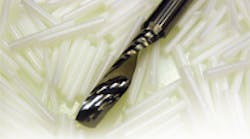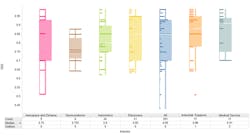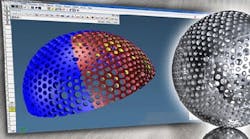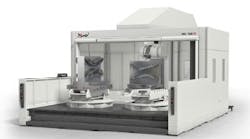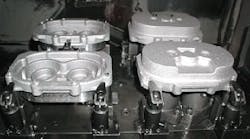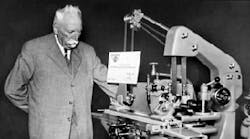Many shops proficient at cutting metal are perplexed when it comes to machining plastics or plastic composites, and for good reason. There are a myriad of plastic compositions, and each responds differently to the cutting process. In addition to the physical properties of the various materials, other less obvious factors, such as a change in color, can drastically alter the way a plastic material reacts to a cutting tool.
Routing and trimming have become some of the most common operations performed during the manufacture of plastic components and finished goods. The key to machining plastic successfully is to match the cutter geometry with the machining characteristics of the material. Although the focus here is on cutter/material characteristics, factors like programming and fixturing techniques are equally critical.
Routing was historically a means of quickly shaping and cutting wood and aluminum, and only occasionally plastics and plastic composites. Plastics machining has completely changed the router industry outlook on cutter design. CNC routing has taken those operations to a new level, and allowed plastic fabricators to put a finished edge on products that previously may have needed further processing.
A good way to understand what to expect from a cutting tool geometry is to categorize plastics according to how they respond to machining.
Geometries for soft plastics
Soft plastics are routed by removing long, curly chips from the face of the material being machined. Normally the release of these chips is quite easy and there is little or no instance of burring or fuzzing at the edge. Abrasive and impact wear is not an issue when cutting soft plastics, and the tool’s rake angle can be large, resulting in an easy release of the chip from the material. This allows fast feedrates and less movement of the part due to cutting pressure.
The tradeoff of a high rake angle in a cutting tool is that it becomes very aggressive. If anyone has ever used dedicated CNC plastic tooling in hand routers, they can attest to the fact that it wants to “run” and can sometimes rip the router from an operator’s grasp. The solution for this aggressiveness is to change both the angle and type of clearance put on soft plastic tooling. A low-angle radial (or eccentric) relief grind on the clearance angle will “calm” the tool and allow the high rake angle to cut freely, while still maintaining control of the cutting tool.
This radial clearance is designed to rub ever so slightly along the cut surface and provide some stability to the cutting tool. However, one or two degrees of too much relief, and the cutting tool will begin to chatter. The resulting knife marks along the cutting edge produce a poor finish. One or two degrees of too little relief and the router bit will rub too much, producing heat that will melt the material.
Additional factors in the design of soft plastic tooling involve removing the chips once they have been cut from the material. If the chips clog the passageway on their way out, they will heat up rapidly, causing a poor part finish and premature tool wear. The solution is to increase the flute area that the chips are allowed to flow to by reducing the number of flutes (thereby increasing the allowable flute opening), and by using “O” flute geometry. “O” flutes allow the chips to form naturally and follow the natural flow of the cutting geometry without hitting sharp corners that might slow their exit from the cut passage.
Geometries for hard plastics
Hard plastics machine much differently from their soft plastic counterparts. The biggest difference is in their production of chips. Machining wood, aluminum, or soft plastic produces large chips that are easily ejected from the router bit path. On the other hand, hard-plastic chips appear very different and normally are very small shards that resemble crystalline fragments or dust. Unlike soft-plastic chips, hard-plastic waste is formed by frequently breaking small, individual chunks of material from the base material. This necessitates different cutter geometries from those used in cutting soft plastics.
Like soft plastics, hard-plastic tooling benefits from an increased rake angle that allows the material to break away easily. However, unlike soft-plastic tooling, there is no need for a dramatically increased rake angle. Because of the willingness of most hard plastics to release their bonds in response to a sharp cutting edge, a moderate increase in rake angle will usually produce the best results. Also, the clearance angle does not need to be reduced as much to control the tool, and frequently a straight relief angle is all that is required to control the tool and prevent chatter.
Hard plastic suffers from the same chatter and melt problems as soft plastic, and it must be controlled through the same tight tolerances for rake and clearance angles. Hard plastics also exhibit “cratering” — a cutting effect rarely seen in softer materials. Because of the manner in which hard plastic is machined, if the rake angle becomes too high, the tendency for the material to break and release its bonds is greatly exaggerated, and the chips will pull additional material from within the cut edge, leaving a cratered or dimpled surface along the finished edge. By tightly controlling the wedge angle of the cutting tool, this can normally be prevented for a reasonable range of cutting speeds.
Whereas soft plastics respond best to “O” flutes, hard plastics generally rout best with modified “O” flutes or a straight-rake face geometry. This, combined with the smaller chips produced, allow multi-fluted spirals to effectively cut the material with a superior finish and good chip extraction.
Geometries for reinforced plastics
Reinforced plastics usually consist of a polyester, epoxy, or phenolic base with either a fibrous or glass material woven or otherwise embedded in, to add rigidity to the composite. While this can add significant strength to the material, it causes it to be extremely difficult to machine.
There are two different methods for attacking the tooling design problem associated with machining abrasive plastics. The first involves using a high rake angle and high clearance angle to allow the bit to cut freely and aggressively and to reduce the amount of heat produced during the cutting operation. Heat is a major factor contributing to accelerated tool wear in these operations. The adverse side to this is that the resultant wedge angle is very small and a weak cutting edge is continually presented to the reinforced plastic that can lead to chipping of the tool, and a general break-down of the cutting edge.
The other method used in the design of composite cutting tools is to present a very strong cutting edge to the material by greatly lowering the rake angle and slightly decreasing the clearance angle. This method reduces the chipping of the cutting edge but can lead to high heat build-up. The best application of these tools requires decreased spindle speeds to reduce the material heating, but this can lead to increased cutting forces and cause part movement.
Machining of reinforced plastics requires that great care be made when choosing one of these two tooling types and that the spindle speed and feed rates are matched to the cutting tool selected, as each requires different cutting properties and heat characteristics to function best. Cutting tools typically consist of spirals and straight rake-face tools, with either radial clearance for low speeds and strong cutting edges or straight clearance for a free cutting action for high speeds.
Importance of chipload
If the part to be machined is fixtured securely and the correct tool has been selected for the material, spindle speed and feedrate will be the determining factors on the quality of the finished part. Speeds and feeds can vary greatly depending on router horsepower, tooling and part composition; however, it is possible to make an educated guess at the correct ratios, and then to fine-tune the finish.
The defining ratio of speed and feed combinations determines chipload — the thickness of the chip that is removed by a cutting edge per revolution.
In effect, increasing the chipload causes a larger chip to be removed. The larger the chip removed, the more heat that is removed with it, and the longer the tool life. The primary means of increasing chipload is to increase the feedrate, as this has the added benefit of increasing the number of finished parts produced per hour. Chipload also can be increased by lowering spindle speed if feedrate is already at a maximum. Decreased chipload means the number of times that a cutting edge is presented to the workpiece is increased. Each router bit edge can be used only a finite number of times before it becomes dull; therefore, the highest chipload that will produce an acceptable finish should be used to prolong cutter life.
It is useful to have some rules-of-thumb for determining feed rates. For the following examples, a spindle speed of 18,000 rpm is assumed. For soft plastics, solid-carbide spiral tools that have specific geometries for cutting that type of plastic can be run at approximately 300 ipm. Solid carbide “O” flutes also should be run that fast to clear the chips. If finish begins to degrade, the spindle speed can be increased to maintain the same production rate. High-speed steel “O” flute tools require slower feedrates to prevent the bit from deflecting and chattering causing knife marks.
Harder plastics work well with low-helix tools that have been designed to break away the plastic chips cleanly. These tools can be run at around 300 ipm. Double-edged “V”-flute tools can run anywhere from 125 to 250 ipm, depending on style and bit composition, and also produce an excellent finish. It is important to understand that in all cases, whether routing hard or soft plastics, the byproduct must be in the form of chips, not dust. Large chips will not re-weld to a cut surface and will prolong the life of the tool. If the cut waste that is produced is dust, that means the chips have been re-cut numerous times or the chipload is too low, and tool life and edge finish will be degraded.
Fiber-reinforced plastics are different from other types of plastics in that it is difficult to determine the type of chip being produced. Because of the structure of materials such as fiberglass, Aramid, and carbon-fiber compounds, chips are not formed during the cutting process. In these instances, it is best to run the bit as fast as possible. The cooler the bit is when finished, the longer will be the expected tool life.
If, despite adjusting speeds and feeds, the best cut still produces a hot tool or causes occasional chip re-welding, forced air can be used to evacuate the chips.
Editor’s note: Information for this article from Onsrud Cutter Inc..
